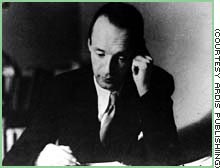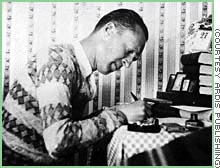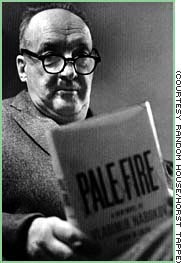The Writer

|
|
| Nabokov in Berlin in 1936. This was his favorite picture of himself. | |
April 9, 1999
Web posted at: 5:36 p.m. EDT (2136 GMT)
(CNN) -- Vladimir Nabokov's relationship with words began at a young age -- he wrote his first poem at the age of 15. Before leaving the Tenishev school, he had privately published two books of poetry.
By the time of his death in 1977, he had published 18 novels, eight books of short stories, along with seven books of poetry and nine plays. In his spare time (when he wasn't collecting, studying and writing about butterflies), Nabokov invented crosswords, translated texts as encompassing as "Alice in Wonderland," wrote academic papers and lectures, critical reviews, and nonfiction works. He also wrote a screenplay for the 1962 movie version of "Lolita," directed by Stanley Kubrick.
|
In short, he was obsessed with words and was not intimidated by genre. He spent his working life trying to capture the perfect style and structure on the page, in the same way he netted a butterfly that fluttered in his path.
Nabokov, known as VN, first gained acclaim in Berlin, writing in his native Russian language and developing a following with fellow émigrés. In 1923, shortly after his graduation from Cambridge, Nabokov was busy with work -- he published four plays (including "Death" and "The Grandfather") and two books of poetry ("The Empyrean Path" and "The Cluster").
His first book, "Mary," was published in 1926. The story details a young émigré's longing for the love he left behind in Russia, the battle between what is memory and what is real, and the inevitable disappointment of facing both. The book received little initial attention.

|
|
| Nabokov working on "The Defense" at a hotel in Le Boulou, East Pyrenees, February 1929 | |
That's not to say Nabokov was an unknown. He continued to write, publishing the novels "King, Queen, Knave" (1928), "The Defense" (1930), and "Glory" (1932) and the 1929 short story collection "The Return of Chorb," Nabokov developed a Russian and French reader base that recognized his budding genius.
"In the 1930s in Germany and Paris, he was considered the leading writer of his generation," says Jeff Edmunds, editor of the Nabokov Web site Zembla.
His first English novel was "The Real Life of Sebastian Knight," a story that chronicles the narrator's search for the "essence" of his half-brother, the title character. The book is filled with trademark Nabokov references to chess, as well as his typical literary games.
|
It was in the late 1930s when his defining achievement, "Lolita," began to take form. Though he abandoned the story for other novels, "Lolita" never left him, and by 1949 it "began to plague me again," he wrote.
When he had finished "Lolita," Nabokov knew what he held in his hands, and he was not shy about sending it to publishing houses for acceptance.
One typical letter to New Directions, dated February 3, 1954, reads:

|
|
| Nabokov's "time bomb" | |
"Would you be interested in publishing a time bomb that I have just finished putting together? It is a novel of 459 typewritten pages."
New Directions, and many others, rejected "Lolita" until the book was finally published in France by Olympia Press in 1955. Putnam later followed with a U.S. publishing in 1958.
The book, a tour of post-World War II America in the form of a middle-aged man's sinful obsession and relations with his 12-year-old "nymphet" stepdaughter, was at once praised and vilified for its content. Some called the work "pornography," something Nabokov debated with zeal.
But many more critics looked beyond shock to discover Nabokov's intricate portrait of America that reveals the loss of love, youth, morals and values.
"He once said 'Lolita' is about his love affair with the English language," says Edmunds.
The book has since been hailed as one of the greatest novels of all time, ranked number four on the Modern Library's controversial list of the best 100 novels of the 20th century.
The work changed Nabokov's life, for better and worse. He made enough money to do as he pleased, and critics now looked upon his work with new respect and intensity. But he also found himself locked in a greater fight for privacy, something he desperately craved.
"Lolita is famous, not I," the author once said.
None of his work went on to achieve the success of "Lolita." But that's not to say that Nabokov failed reach new plateaus. To the contrary, Nabokov was alway seeking the new -- style, story, horizon.
"Pale Fire" was the much-anticipated 1962 follow-up to the American publishing of "Lolita", and left many readers shaking their heads. The book, a complicated effort centered around a 999-line poem called "Pale Fire" by assassinated American poet John Shade, forces the reader to flip back and forth through fictitious references and footnotes.

|
|
| Nabokov with the first edition of "Pale Fire," 1962 | |
Donald Malcolm of "The New Yorker" noted that, "It is not reading in the ordinary sense. It more nearly resembles the manipulation of pencil along a course of numbered dots until the hidden picture stands forth, compact, single and astonishing." In other words, it was evidence that Nabokov was taking the medium of the novel to new places, investigating and inventing new ways to present a story.
His talents may have reached a peak in 1969. If you were to ask Nabokov which novel was his best, he would certainly acknowledge the power of "Lolita" but would probably point to "Ada or Ardor: A Family Chronicle" published in 1969 to stellar reviews. The book, regarded as a culmination of Nabokov's talents, tells a family chronicle of incest, with a science fiction setting and numerous references to the author's own work.
Nabokov called it "A book of genius, the pearl of American literature."
Nabokov was working on a novel when he died in 1977. "The Original of Laura" was never finished.
Nabokov's work was discovered by a new generation of readers with the remake of the movie "Lolita." As with the first one, 1997's "Lolita" starring Dominique Swain and Jeremy Irons caused controversy and failed to land a U.S. distributor during its first run.
Nearly 40 years after the work was published in the U.S., Nabokov's description of the story still fit -- it was still considered a "time bomb."